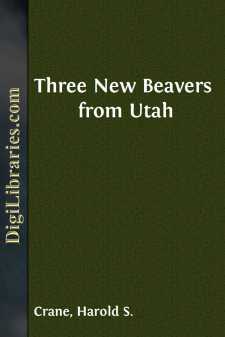Categories
- Antiques & Collectibles 13
- Architecture 36
- Art 48
- Bibles 22
- Biography & Autobiography 813
- Body, Mind & Spirit 142
- Business & Economics 28
- Children's Books 14
- Children's Fiction 11
- Computers 4
- Cooking 94
- Crafts & Hobbies 4
- Drama 346
- Education 46
- Family & Relationships 57
- Fiction 11829
- Games 19
- Gardening 17
- Health & Fitness 34
- History 1377
- House & Home 1
- Humor 147
- Juvenile Fiction 1873
- Juvenile Nonfiction 202
- Language Arts & Disciplines 88
- Law 16
- Literary Collections 686
- Literary Criticism 179
- Mathematics 13
- Medical 41
- Music 40
- Nature 179
- Non-Classifiable 1768
- Performing Arts 7
- Periodicals 1453
- Philosophy 64
- Photography 2
- Poetry 896
- Political Science 203
- Psychology 42
- Reference 154
- Religion 513
- Science 126
- Self-Help 84
- Social Science 81
- Sports & Recreation 34
- Study Aids 3
- Technology & Engineering 59
- Transportation 23
- Travel 463
- True Crime 29
Three New Beavers from Utah
by: Harold S. Crane
Description:
Excerpt
The subspecific identity of beavers from Utah seems never to have been carefully investigated. With the exception of the name Castor canadensis repentinus applied to animals from Zion and Parunuweap canyons by Presnall (1938:14), all other writers from 1897 until the present time, have used for animals from Utah, the name combination Castor canadensis frondator Mearns, the type of which is from Sonora, Mexico. Study of specimens of beavers from Utah, accumulated in the collections of the Museum of Zoology, University of Utah, proves these animals to be far more variable than formerly supposed, and discloses the existence of three hitherto unnamed kinds, which are named and described below.
We recognize the need for caution in proposing new names for American beavers, because the transplanting of these animals from one watershed to another may have permitted the animals of a given area to change genetically, say, through hybridization, and may also have altered the geographic distribution of the several kinds. The officials of the Utah State Fish and Game Commission have assured us that such transplants have not occurred in the areas where these three new kinds are found, and further that nowhere in the state have transplants been made from one major drainage system to another; such transplants as have been made were only within the same major drainage system.
The capitalized color terms used in this paper are after Ridgway, Color Standards and Color Nomenclature, Washington, D. C., 1912. All measurements are in millimeters. We are indebted to the officials of the United States National Museum for the loan of comparative materials.
Castor canadensis pallidus new subspecies
Type.âFemale, adult, skin and skull, number 719, Museum of Zoology, University of Utah; Lynn Canyon, 7,500 ft., Boxelder County, Utah; September 7, 1932; collected by W. W. Newby.
Range.âKnown only from the Raft River Mountains.
Diagnosis.âSize small; tail and hind foot short (see measurements). Color (type): Pale, upper parts uniformly Ochraceous-Buff; underfur Snuff Brown; underparts uniformly Light Buff, grading to Light Ochraceous-Buff at base of tail; underfur Light Drab; front and hind feet Light Ochraceous-Buff. Skull: Rostrum short; nasals broad (breadth averaging 54 per cent of length), constricted posteriorly and barely projecting posteriorly beyond premaxillae; zygomatic arches robust, but not widely spreading (zygomatic breadth 77 per cent of basilar length); mastoid breadth 73 per cent of zygomatic breadth; anterolateral margin of orbit narrow (6.2); occipital condyles visible from dorsal view; condylobasal length greater than occipitonasal length; upper incisors narrow (Orange Chrome in color); coronoid processes high and wide; cheek teeth narrow.
Measurements.âMeasurements of the type are as follows: Total length, 1040; length of tail, 380; length of hind foot, 157; length of ear, 35; occipitonasal length, 129.1; basilar length, 116.6; mastoid breadth, 65.6; interorbital breadth, 23.6; length of nasals, 43.3; zygomatic breadth, 89.7; breadth of nasals, 23.4; alveolar length of upper molariform teeth, 30.4.
Comparisons.âFrom topotypes and near topotypes of Castor canadensis taylori, C. c. pallidus differs as follows: Size smaller; tail and hind foot shorter. Color: Markedly lighter throughout. Skull: Nasals shorter and wider (breadth of nasals averages 54 per cent of length of nasals, as opposed to 46 per cent); nasals barely projecting posteriorly beyond premaxillae; rostrum shorter; zygomatic breadth relative to basilar length less; mastoid breadth actually as well as relatively greater; interorbital breadth greater; occipitonasal length shorter rather than longer than condylobasal length; tympanic bullae smaller; coronoid process higher and wider; cheek teeth narrower....


